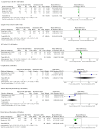Basal cisternostomy as an adjunct to decompressive hemicraniectomy in moderate to severe traumatic brain injury: a systematic review and meta-analysis
- PMID: 39354191
- PMCID: PMC11445355
- DOI: 10.1007/s10143-024-02954-4
Basal cisternostomy as an adjunct to decompressive hemicraniectomy in moderate to severe traumatic brain injury: a systematic review and meta-analysis
Abstract
Background: Basal cisternostomy (BC) is a surgical technique to reduce intracranial hypertension following moderate to severe traumatic brain injury (TBI). As the efficacy and safety of BC in patients with TBI has not been well-studied, we aim to summarize the published evidence on the effect of BC as an adjunct to decompressive hemicraniectomy (DHC) on clinical outcome following moderate to severe TBI.
Methods: A systematic literature review was carried out in PubMed/MEDLINE and EMBASE to identify studies evaluating BC as an adjunct to decompressive hemicraniectomy (DHC) in moderate to severe TBI. Random effects meta-analysis was performed to calculate summary effect estimates.
Results: Eight studies reporting on 1345 patients were included in the qualitative analysis, of which five (1206 patients) were considered for meta-analysis. Overall, study quality was low and clinical heterogeneity was high. Adjuvant BC (BC + DHC) compared to standalone DHC was associated with a reduction in the length of stay in the ICU (Mean difference [MD]: -3.25 days, 95% CI: -5.41 to -1.09 days, p = 0.003), significantly lower mean brain outward herniation (MD: -0.68 cm, 95% CI: -0.90 to -0.46 cm, p < 0.001), reduced odds of requiring osmotherapy (OR: 0.09, 95% CI: 0.02 to 0.41, p = 0.002) as well as decreased odds of mortality at discharge (OR 0.68, 95% CI: 0.4 to 0.96, p = 0.03). Adjuvant BC compared to DHC did not result in higher odds of a favourable neurological outcome (OR = 2.50, 95% CI: 0.95-6.55, p = 0.06) and did not affect mortality at final follow-up (OR: 0.80, 95% CI: 0.17 to 3.74, p = 0.77).
Conclusion: There is insufficient data to demonstrate a potential beneficial effect of adjuvant BC. Despite some evidence for reduced mortality and length of stay, there is no effect on neurological outcome. However, these results need to be interpreted with caution as they carry a high risk of bias due to overall scarcity of published clinical data, technical variations, methodological differences, limited cohort sizes, and a considerable heterogeneity in study design and reported outcomes.
Keywords: Basal cisternostomy; Cisternal drainage; Decompressive hemicraniectomy; Head injury; Intracranial pressure; Traumatic brain injury.
© 2024. The Author(s).
Conflict of interest statement
The authors declare that the article and its content were composed in the absence of any commercial or financial relationships that could be construed as a potential conflict of interest.
Figures




References
-
- Murray GD et al (1999) mar., The European Brain Injury Consortium Survey of Head Injuries, Acta Neurochir. (Wien), vol. 141, fasc. 3, pp. 223–236, 10.1007/s007010050292 - PubMed
-
- Stocchetti N et al (2008) mar., Refractory intracranial hypertension and second-tier therapies in traumatic brain injury, Intensive Care Med., vol. 34, fasc. 3, pp. 461–467, 10.1007/s00134-007-0948-9 - PubMed
-
- Ghajar J, injury Traumaticbrain (9233) The Lancet, vol. 356, fasc. pp. 923–929, set. 2000, 10.1016/S0140-6736(00)02689-1
-
- Waqas M et al (2016) mar., Predicting outcomes of decompressive craniectomy: use of Rotterdam Computed Tomography Classification and Marshall Classification, Br. J. Neurosurg., vol. 30, fasc. 2, pp. 258–263, 10.3109/02688697.2016.1139047 - PubMed
Publication types
MeSH terms
LinkOut - more resources
Full Text Sources
Medical
Research Materials

